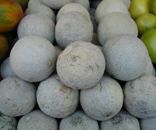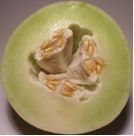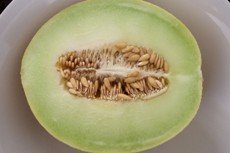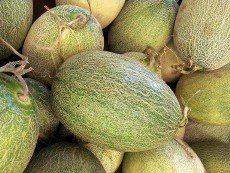Honeydew Melon: Origins - Consumption - Nutrition Facts - Health Benefits
|
|
|
Contents
- Geographic origin and regions grown
- History of consumption
- Common consumption today
- Nutrition Facts: Vitamins, minerals and phytochemical components
- Health Benefits: Medicinal uses based on scientific studies
- Bibliography
Geographic Origins and Regions Grown
 |
 |
Melons belong to the family Cucurbitaceae. The most common species of the Honeydew Melon is the Cucumis melo Inodorus Group and well known cultivars include crenshaw, casaba, persian, and winter. Honeydew is also the American name for the cultivar White Antibes which has been grown for many years in Southern France and Algeria.
Muskmelons, winter melons, and European cantaloupes grow on vines that are generally classified as Cucumis melo. Muskmelons are derived from the Cucumis melo variety called reticulatus, while Winter melons are derived from the Cucumis melo variety called Inodorus. The European cantaloupe grows on a Cucumis melo vine called cantalupensis. Watermelons grow on the vine classified as Citrullus lanatus.
A Honeydew Melon has a round to slightly oval shape and is typically 15-22 cm long. The melons generally range in weight from 1.8 to 3.6 kg. The flesh of honeydew is pale green in color, while the smooth peel ranges from green to yellow and has many seeds. This fruit grows best in semiarid climates and is harvested based on maturity, not size. Maturity can be hard to judge, but is based upon a melon’s color, which ranges from greenish white (immature) to creamy yellow (mature).
Quality is also determined by whether or not the honeydew has a nearly spherical shape and a surface that is free of scars or defects. Also, honeydews should feel heavy for its size and have a waxy, not fuzzy surface. The name casaba comes from Kasaba, a town in Turkey.
History of Consumption
 |
 |
Melon is the common name for any one of the numerous varieties of sweet fruits in the gourd family that grow on two species of trailing vines. One vine bears muskmelons, winter melons, and the European cantaloupe. The other bears the watermelons.
Muskmelons have a soft, ribbed rind with distinct netting, salmon-colored pulp, and a musky aroma. They are the most perishable of the melons and are particularly popular in North America, where they are also called cantaloupes. The name was taken from its quite distant relative the European cantaloupe.
Winter melons, from which the honeydew, Persian, casaba, and Crenshaw are best known, are less aromatic than muskmelons. They take more time to mature and have harder rinds that preserve them well after the growing season.
In contrast, the honeydew has a smooth rind with a green pulp. The Persian has a dark rind with orange pulp. The casaba has a yellow, wrinkled rind with green or white pulp and the Crenshaw has a dark green, wrinkled rind with pink pulp.
The true cantaloupe is grown mostly in Europe and its name is derived from the village of Cantalupo, near Rome, where it may have been introduced from Armenia. True cantaloupes have hard, warty, scaly rinds with deep grooves and do not have the characteristic netting of typical muskmelons.
Watermelons vary in shape, size, and markings and range from round to oblong. These melons can be 1 to 20 kg (2.2 to 45 lb), and may be dark green to striped light green. The flesh of these varieties is usually red, quite sweet, extremely watery, and distinctly crisp.
The group of muskmelons, winter melons, and European cantaloupes is believed to have originated in Iran and the Transcaucasia before it was cultivated by the Egyptians, the Greeks, and Romans. Watermelons originated in tropical Africa and Sanskrit and early Egyptian records indicate that they have been cultivated for more than 4000 years.
Common Consumption Today
Melons of all kinds are often eaten fresh after being chilled or as a part of a fresh fruit salad or even mixed with yogurt. Honeydew melons can also be used to flavor sorbet and ice creams and are also very popular additions to smoothies. They can be baked or served as part of a chilled soup.
Vitamins, Minerals and Phytochemical Components
Honeydew melons contain vitamin C, B6, B12, A, E, thiamin, riboflavin, niacin, pantothenic acid, folic acid and Beta-carotene (1). They also contain calcium, potassium, magnesium, iron, phosphorus, sodium, zinc, copper, manganese, selenium, and small amounts of dietary fiber.
Honeydew-Melon-Nutrition-Table
Medicinal Uses Based on Scientific Studies
Honeydew melons are a source of polyphenol antioxidants, which are chemicals known to provide certain health benefits to the cardiovascular and immune system (1). These chemicals are also known to regulate the formation of nitric oxide, which is an effective chemical that promotes the health of the endothelium and prevention of heart attacks (2). In addition, recent studies have shown that melons act like diuretics due to their ability to lower high blood pressure (3).
Bibliography
- Sundia Honeydew. Honeydew health benefits, honeydew nutritional facts. Retrieved on October 23, 2007 from http://www.sundiacorp.com/SundiaFruits/Sundia- Honeydew/Nutritions.php
- Wikipedia Foundation, Inc. (2007) Cantaloupe. Retrieved October 23, 2007 from http://en.wikipedia.org/wiki/Cantaloupe#References
- Wright CI, Van-Buren L, Kroner CI, Koning MM. (2007) Herbal medicines as diuretics: a review of the scientific evidence. Journal of Ethnopharmacology, 8;114(1):1-31
Disclaimer
Nutritiousfruit.com provides this website as a service. Although the information contained within the website is periodically updated, no guarantee is given that the information provided is correct, complete, and/or up-to-date. The materials contained on this website are provided for general information purposes only and do not constitute legal or other professional advice on any subject matter. Nutrtiousfruit.com does not accept any responsibility for any loss, which may arise from reliance on information contained on this website. The information and references in this website are intended solely for the general information for the reader. The content of this website are not intended to offer personal medical advice, diagnose health problems or to be used for treatment purposes. It is not a substitute for medical care provided by a licensed and qualified health professional. Please consult your health care provider for any advice on medications.
Didn't find what you were looking for? Search here...

Amazon Search Box:
Did you like this page?
|
|
|




